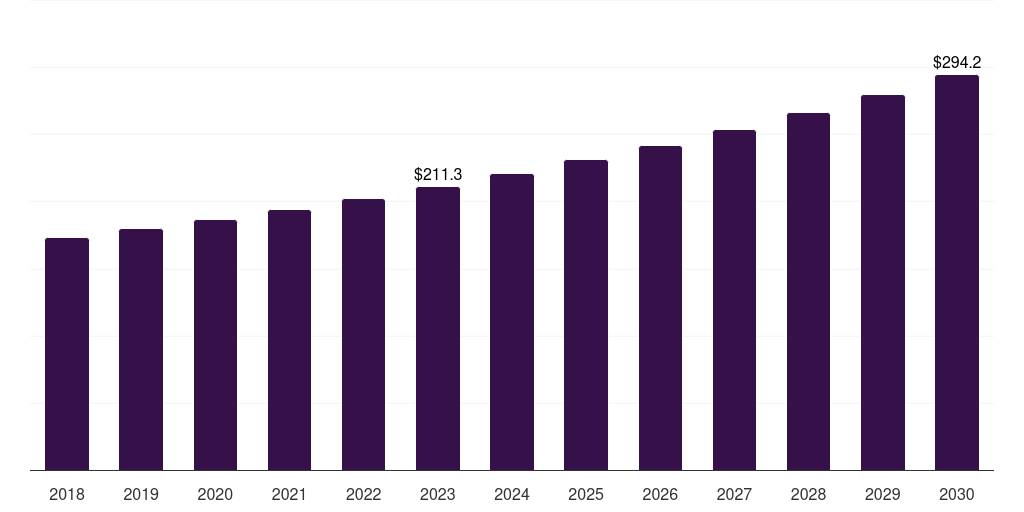Australia Antifungal Drugs Market Size & Outlook
Australia antifungal drugs market, 2018-2030 (US$M)
Related Markets
Australia antifungal drugs market highlights
- The Australia antifungal drugs market generated a revenue of USD 211.3 million in 2023 and is expected to reach USD 294.2 million by 2030.
- The Australia market is expected to grow at a CAGR of 4.8% from 2024 to 2030.
- In terms of segment, azoles was the largest revenue generating drug class in 2023.
- Echinocandins is the most lucrative drug class segment registering the fastest growth during the forecast period.
Antifungal drugs market data book summary
| Market revenue in 2023 | USD 211.3 million |
| Market revenue in 2030 | USD 294.2 million |
| Growth rate | 4.8% (CAGR from 2023 to 2030) |
| Largest segment | Azoles |
| Fastest growing segment | Echinocandins |
| Historical data | 2018 - 2022 |
| Base year | 2023 |
| Forecast period | 2024 - 2030 |
| Quantitative units | Revenue in USD million |
| Market segmentation | Azoles, Echinocandins, Polyenes, Allylamines |
| Key market players worldwide | Novartis AG ADR, Pfizer Inc, Bayer AG, Sanofi SA, Merck KGaA, Merck & Co Inc, GlaxoSmithKline, Abbott Laboratories, Enzon Pharmaceuticals Inc, Astellas Pharma Inc, Glenmark Pharmaceuticals |
Other key industry trends
- In terms of revenue, Australia accounted for 1.3% of the global antifungal drugs market in 2023.
- Country-wise, U.S. is expected to lead the global market in terms of revenue in 2030.
- In Asia Pacific, Japan antifungal drugs market is projected to lead the regional market in terms of revenue in 2030.
- China is the fastest growing regional market in Asia Pacific and is projected to reach USD 1,381.0 million by 2030.
Azoles was the largest segment with a revenue share of 48.04% in 2023. Horizon Databook has segmented the Australia antifungal drugs market based on azoles, echinocandins, polyenes, allylamines covering the revenue growth of each sub-segment from 2018 to 2030.
Players are entering the market to capitalize on opportunities in the lucrative market. For instance, Cresemba (isavuconazole) was launched in Australia by Pfizer, Inc., which holds sales license for the product in Asia Pacific.
This drug is from azole class and is used for mucormycosis and invasive aspergillosis treatment. This drug is expected to provide a new treatment option to patients. Furthermore, the Pharmaceutical Benefits Scheme covers antifungal drugs, which improves access to these drugs.
Moreover, key players, such as Bayer, are organizing campaigns across the nation to improve awareness among the young population. This is expected to improve fungal infection diagnosis rate and increase treatment rate, thereby propelling antifungal drugs market growth.
No credit card required*
Horizon in a snapshot
- 30K+ Global Market Reports
- 120K+ Country Reports
- 1.2M+ Market Statistics
- 200K+ Company Profiles
- Industry insights and more
Antifungal Drugs Market Scope
Antifungal Drugs Market Companies
| Name | Profile | # Employees | HQ | Website |
|---|
Australia antifungal drugs market size, by drug class, 2018-2030 (US$M)
Australia Antifungal Drugs Market Outlook Share, 2023 & 2030 (US$M)
Related regional statistics
No records
No related regions found.
Sign up - it's easy, and free!
Sign up and get instant basic access to databook, upgrade
when ready, or enjoy our
free plan indefinitely.
Included in Horizon account
- 30K+ Global Market Reports
- 120K+ Country Reports
- 1.2M+ Market Statistics
- 200K+ Company Profiles
- Industry insights and more



